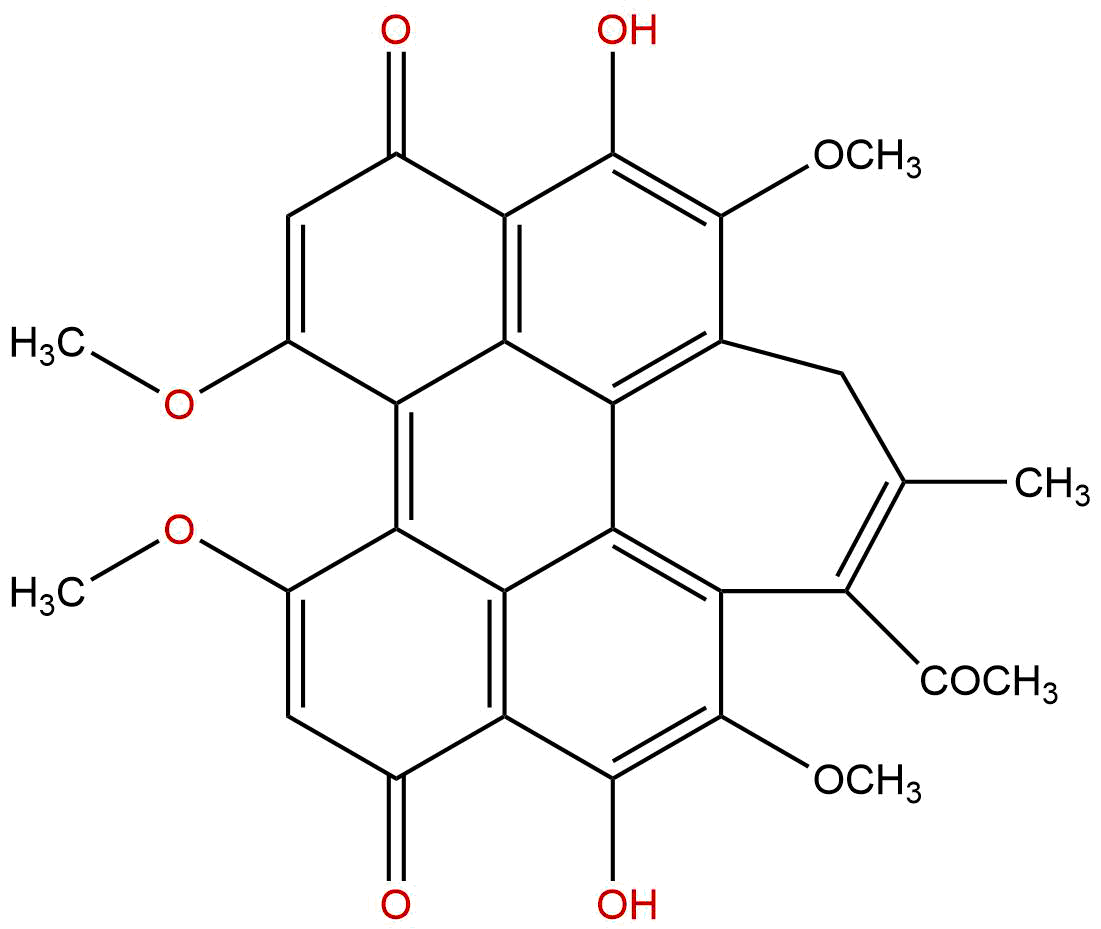
Hypocrellin BCAS No.:123940-54-5
|
||||||||||
 |
|
|
||||||||

| Catalogue No.: | BP0755 |
| Formula: | C30H24O9 |
| Mol Weight: | 528.513 |
Product name: Hypocrellin B
Synonym name:
Catalogue No.: BP0755
Cas No.: 123940-54-5
Formula: C30H24O9
Mol Weight: 528.513
Botanical Source: Hypocrella bambusae (Berk. et Br.) Sacc
Physical Description:
Type of Compound: Anthraquinones
Purity: 95%~99%
Analysis Method: HPLC-DAD or/and HPLC-ELSD
Identification Method: Mass, NMR
Packing: Brown vial or HDPE plastic bottle
Storage: Store in a well closed container, protected from air and light. Put into refrigerate or freeze for long term storage.
Whenever possible, you should prepare and use solutions on the same day. However, if you need to make up stock solutions in advance, we recommend that you store the solution as aliquots in tightly sealed vials at -20℃. Generally, these will be useable for up to two weeks.
The product could be supplied from milligrams to grams
Inquire for bulk scale.
Description:
Hypocrellin B has sonodynamic action to induce mitochondrial damage, survival inhibition, apoptosis and inhibit adhesion and migration of cancer cells. Photodynamic therapy with Hypocrellin B can remarkably induce apoptosis and inhibit adhesion and migration of cancer cells in vitro.
References:
Int J Radiat Biol. 2014 Jul;90(7):575-9.
Effect of photodynamic therapy with hypocrellin B on apoptosis, adhesion, and migration of cancer cells.
In the present study, we investigated effects of photodynamic therapy with Hypocrellin B on apoptosis, adhesion, and migration of cancer cells in vitro.
METHODS AND RESULTS:
Human ovarian cancer HO-8910 cell as a cancer model cell was incubated with Hypocrellin B at a concentration of 2.5 μM for 5 h and irradiated by light from a light-emitting diodes (LED) source. Cell apoptosis was analyzed by flow cytometry with annexin V/propidium iodide (PI) staining and nuclear staining 6 h after Hypocrellin B photoirradiation. Cell adhesion was assessed using the 3-(4, 5-dimthylthiazol-2-yl)-2, 5 diphenyl-tetrazolium bromide (MTT) assay 4 h after photodynamic treatment. Cell migration was measured 48 h after photodynamic treatment. Flow cytometry with annexin V/PI staining showed that early apoptotic and late apoptotic (necrotic) rates following photodynamic therapy with Hypocrellin B markedly increased to 16.40% and 24.67%, respectively. Nuclear staining found nuclear condensation and typical apoptotic body in the treated cells. The number of cell migration was significantly decreased to 183 ± 28 after photodynamic therapy with Hypocrellin B (p < 0.01). Light irradiation alone and Hypocrellin B alone had no significant effect on cell migration. The cell adhesion inhibitory rate due to photodynamic action of Hypocrellin Bwas 53.2 ± 1.8%, significantly higher than 2.7 ± 2.1% of light treatment alone and 1.0 ± 0.4% of Hypocrellin B treatment alone (p < 0.01).
CONCLUSIONS:
The findings demonstrated that photodynamic therapy with Hypocrellin B remarkably induced apoptosis and inhibited adhesion and migration of cancer cells in vitro.
Ultrasonics. 2012 Apr;52(4):543-6.
Hypocrellin B-mediated sonodynamic action induces apoptosis of hepatocellular carcinoma cells.
The present study aims to investigate apoptosis of hepatocellular carcinoma cells induced by Hypocrellin B-mediated sonodynamic action.
METHODS AND RESULTS:
The Hypocrellin B concentration was kept constant at 2.5 μM and cells from the hepatocellular carcinoma HepG2 cell line were exposed to ultrasound with an intensity of 0.46 W/cm(2) for 8s. Cell cytotoxicity was quantified using an MTT assay 24 h after sonodynamic therapy (SDT) of Hypocrellin B. Apoptosis was investigated using a flow cytometry with Annexin V-FITC and propidium iodine staining. Intracellular reactive oxygen species (ROS) levels were detected using a flow cytometry with 2,7-dichlorodihydrofluorecein diacetate (DCFH-DA) staining. The cytotoxicity of Hypocrellin B-mediated sonodynamic action on HepG2 cells was significantly higher than those of other treatments including ultrasound alone, Hypocrellin B alone and sham treatment. Flow cytometry showed that Hypocrellin B-induced sonodynamic action markedly enhanced the apoptotic rate of HepG2 cells. Increased ROS was observed in HepG2 cells after being treated with Hypocrellin B-mediated sonodynamic action.
CONCLUSIONS:
Our data demonstrated that Hypocrellin B-mediated sonodynamic action remarkably induced apoptosis of HepG2 cells, suggesting that apoptosis is an important mechanism of cell death induced by Hypocrellin B-mediated SDT.
HPLC of Hypocrellin B
